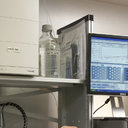Morphological analysis of the 6b oncogene-induced enation syndrome.
Słowa kluczowe
Abstrakcyjny
CONCLUSIONS
The T-DNA 6b oncogene induces complex and partly unprecedented phenotypic changes in tobacco stems and leaves, which result from hypertrophy and hyperplasia with ectopic spot-like, ridge-like and sheet-like meristems. The Agrobacterium T-DNA oncogene 6b causes complex growth changes in tobacco including enations; this unusual phenotype has been called "6b enation syndrome". A detailed morphological and anatomical analysis of the aerial part of Nicotiana tabacum plants transformed with a dexamethasone-inducible dex-T-6b gene revealed several striking growth phenomena. Among these were: uniform growth of ectopic photosynthetic cells on the abaxial leaf side, gutter-like petioles with multiple parallel secondary veins, ectopic leaf primordia emerging behind large glandular trichomes, corniculate structures emerging from distal ends of secondary veins, pin-like structures with remarkable branching patterns, ectopic vascular strands in midveins and petioles extending down along the stem, epiascidia and hypoascidia, double enations and complete inhibition of leaf outgrowth. Ectopic stipule-like leaves and inverted leaves were found at the base of the petioles. Epinastic and hyponastic growth of petioles and midveins yielded complex but predictable leaf folding patterns. Detailed anatomical analysis of over sixty different 6b-induced morphological changes showed that the different modifications are derived from hypertrophy and abaxial hyperplasia, with ectopic photosynthetic cells forming spot-like, ridge-like and sheet-like meristems and ectopic vascular strands forming regular patterns in midveins, petioles and stems. Part of the enation syndrome is due to an unknown phloem-mobile enation factor. Graft experiments showed that the 6b mRNA is mobile and could be the enation factor. Our work provides a better insight in the basic effects of the 6b oncogene.


